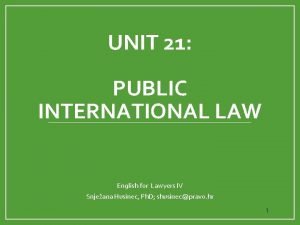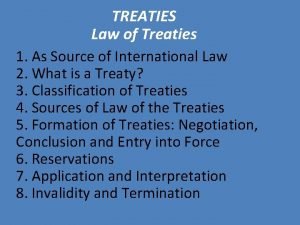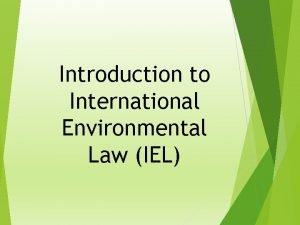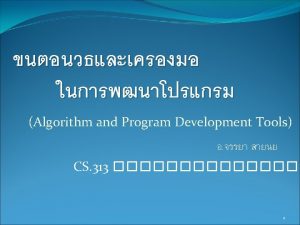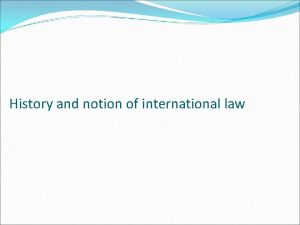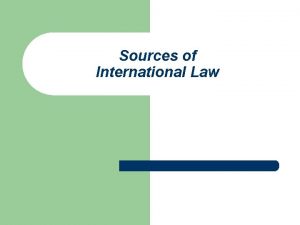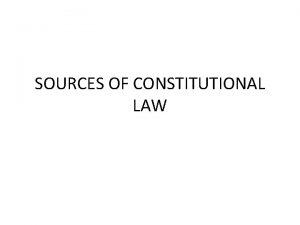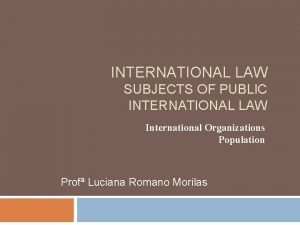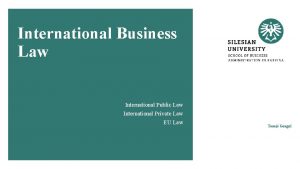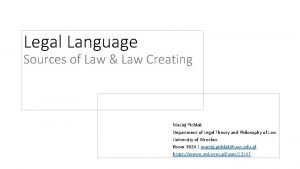Sources of international law Notion of sources Legal













- Slides: 13

Sources of international law

Notion of sources Legal processes and methods for the creation of international law International Court of Justice (ICJ), Art. 38 of the Statute 1. The Court, whose function is to decide in accordance with international law such disputes as are submitted to it, shall apply:

a) international conventions, whether general or particular, establishing rules expressly recognized by the contesting States; b) international custom, as evidence of a general practice accepted as law; c) the general principles of law recognized by civilized nations d) subject to provisions of Article 59, judicial decisions and the teachings of the most qualified publicists of the various nations, as subsidiary means for the determination of rules of law.

Customary law Objective (material) element: state practice Subjective (psychological) element: conviction of states, that their conduct is governed by law „Opinio iuris (sive necessitatis)”

Potential forms of state practice Diplomatic correspondance Policy statements Press releases Official manuals on legal questions National laws Judgments of domestic courts Practice of international organizations

Modalities of state practice Duration: depends on the circumstances, but requires repetition (no instant practice) Uniformity and generality 1969. ICJ. North Sea Continental Shelf cases: ‘both extensive and virtually uniform’ 1986. ICJ. Nicaragua: ‘conduct of states should, in general, be consistent with such rules’ Acceptance of states whose interests are specifically affected (”deeper of set of footprints”)

Protest, acquiescence and change 1984. ICJ. Gulf of Maine: acquiescence is ‘equal to tacit recognition manifested by unilateral conduct which the other party may interpret as consent’ Generally, if states acquiesce in the development of new customary rules it can be deemed as reinforcing it BUT: states may not protest for different reasons! Persistent objector: objection against a newly emerging customary rule since its inception, the new norm is inapplicable to the objector

General principles of law (recognised by civilised nations) Certain legal principles that can be found in all major legal systems (continental, common law, Asian etc. ) Eg: binding force of treaties, finality of judgments (res judicata), good faith (bona fides), compensation (indemnity)

Ius cogens Art. 53. of Vienna Convention on the Law of Treaties A norm accepted and recognized by the international community of states as a whole as a norm from which no derogation is permitted and which can be modified only by a subsequent norm of general international law having the same character.

Erga omnes ICJ. Barcelona Traction case Erga omnes obligations: owed to the international community as such Legal norms which protect the entire international community, it is the legal interest of all states to enforce them Prohibition of genocide, slavery, aggression, racial discrimination, right to selfdetermination, humanitarian rules

Resolutions of international organizations Usually non-binding except for member states UN General Assembly resolutions: might be evidence of custom if (i) predominant majority of states - including states whose interest are specially affected -, (ii) repeatedly, (iii) adopt it with the same content. Moreover, they might constitute authoritative interpretation of the UN Charter. SC resolutions: binding if adopted with reference to breach or threat to peace or aggression.

Soft law Role: not legal norm but might be important for the development of international law (e. g. international environmental law) 2 types: - Non-binding terms in a binding treaty, e. g. „The parties will endeavour. . ”, „attempt” - Apparently binding language but the parties only wanted a political agreement. E. g. 1974. Helsinki Final Act.

Relationship of international law and domestic (municipal) law Dualism: international law and domestic law are separate legal orders, cannot overrule each other International legal rules become domestic norms through transformation Monism: international law and domestic law comprise of one single legal system Incorporation: international law is automatically part of the law of the land
 Sources of international law
Sources of international law Termination of treaties
Termination of treaties Sources of international law
Sources of international law Scope of international law
Scope of international law Newton's first law and second law and third law
Newton's first law and second law and third law Newton's first law of motion
Newton's first law of motion V=k/p
V=k/p Charles law constant
Charles law constant Print and web sources
Print and web sources Important of water management
Important of water management +notion +trial
+notion +trial Business plan cours
Business plan cours Notion of algorithm
Notion of algorithm Notion venture glove
Notion venture glove
